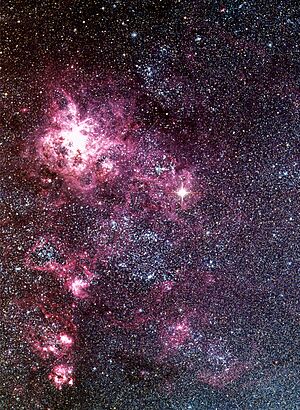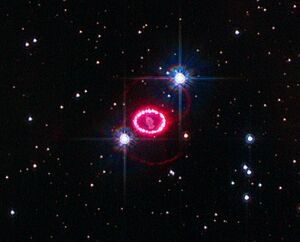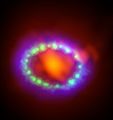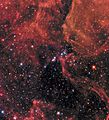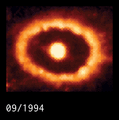SN 1987A facts for kids
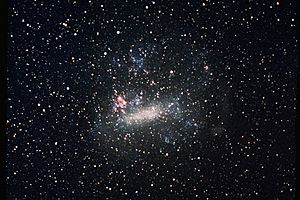
SN 1987A was a huge star explosion, called a supernova. It happened in a small galaxy that orbits our own Milky Way galaxy. This supernova was incredibly far away, about 168,000 light-years from Earth. This means the explosion actually happened 168,000 years ago, but its light only reached us in 1987.
Scientists were very excited about SN 1987A because it was close enough for them to study it in detail. It was the brightest object seen from Earth in over 400 years! Before the light from the explosion even arrived, scientists detected tiny particles called neutrinos. This was a big deal because it helped them understand more about how stars explode.
Contents
What is a Supernova?
A supernova is one of the biggest explosions in space. It happens when a massive star reaches the end of its life. The star runs out of fuel and can no longer support itself against its own gravity. This causes its core to collapse very quickly, leading to a giant explosion that shines brighter than an entire galaxy for a short time.
Why SN 1987A Was Special
SN 1987A was the closest supernova to Earth that scientists have been able to study with modern tools. Before 1987, there were other supernovas that were closer, but they happened before we had advanced telescopes and detectors. This made SN 1987A a unique chance to learn about these powerful events.
Scientists learned a lot from SN 1987A. For example, they saw the neutrinos first, which confirmed their ideas about how supernovas create these particles. They also watched how the leftover material from the explosion expanded and changed over time.
Finding the Star's Remnant
After a supernova, what's left behind is called a remnant. This is a cloud of gas and dust that keeps expanding. Scientists believed there had to be a very dense object, like a neutron star or a black hole, at the center of SN 1987A's remnant.
For a long time, it was hard to find this central object because it was hidden by a lot of dust. But scientists now believe they have finally found the dead star's core. This discovery helps them understand the final stages of a star's life and what happens after a supernova.
Images for kids
-
Remnant of SN 1987A seen in light overlays of different spectra. ALMA data (radio, in red) shows newly formed dust in the center of the remnant. Hubble (visible, in green) and Chandra (X-ray, in blue) data show the expanding shock wave.
-
The expanding ring-shaped remnant of SN 1987A and how it interacts with its surroundings, seen in X-ray and visible light.
See also
 In Spanish: SN 1987A para niños
In Spanish: SN 1987A para niños


